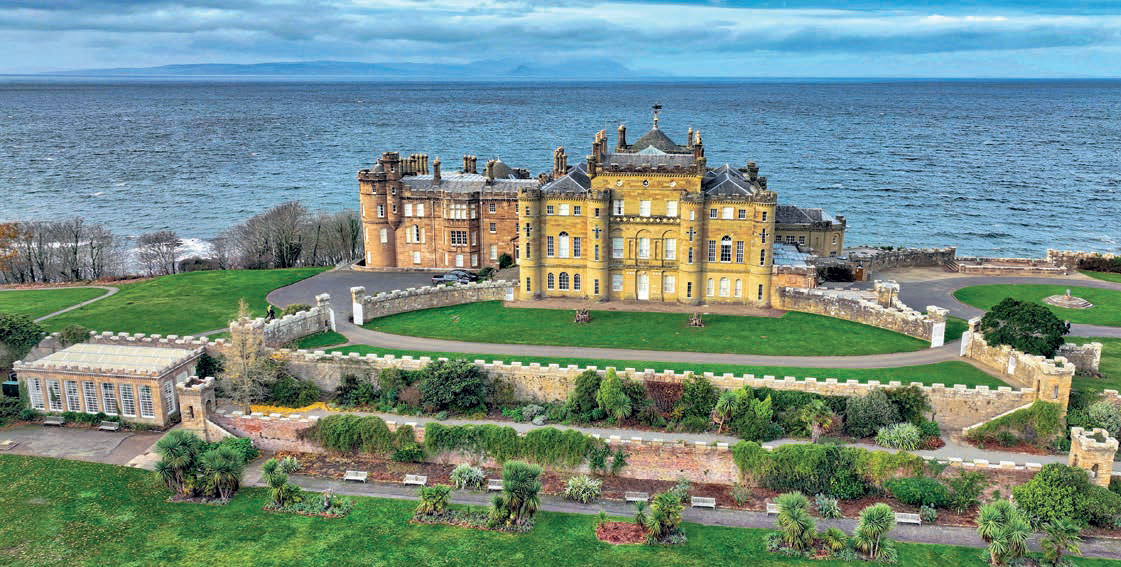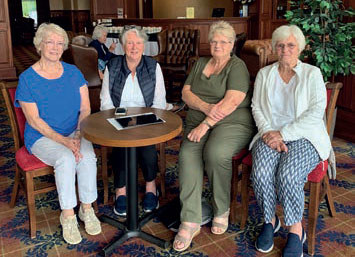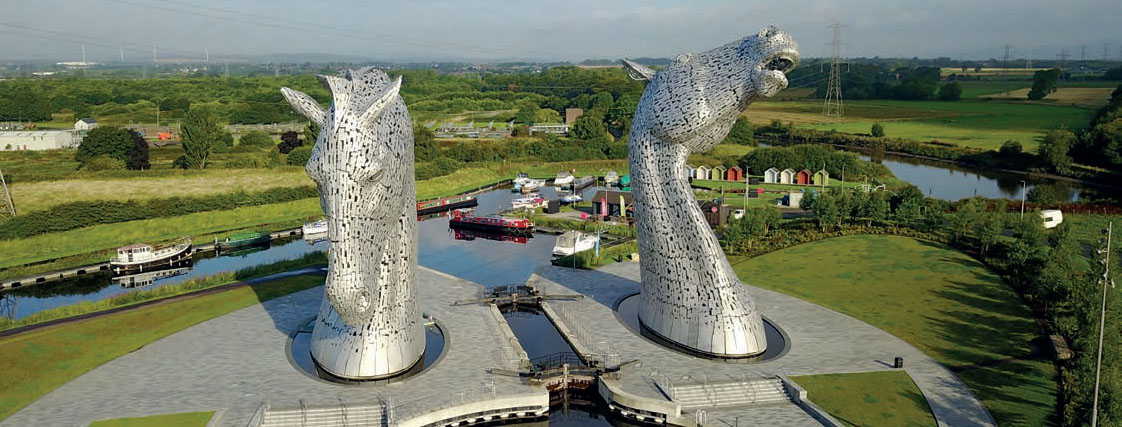Issue 57, Spring 2023

Balmoral castle & Gardens
Lochs and Glens guests have been enjoying visits to Balmoral for several years.
In fact, in guest surveys they have been frequently rated as having been one of the highlights of their holiday and I am pleased to say that we have arranged a further series of visits during 2023 and 2024 in a number of Loch Tummel Hotel itineraries.
The first historical reference to Balmoral is the construction of a house for a Sir William Drummond in 1390. Since that time the estate has had a turbulent history as it passed through a series of owners including members of the Clan Farquharson who, as Jacobite sympathisers, suffered its forfeiture after the rebellions of 1715 and 1745 were quashed.
In 1848 Prince Albert acquired the lease on Balmoral, after Queen Victoria’s doctor recommended Deeside for its healthy climate and the first royal visit occurred in September 1848. Victoria found the house “small but pretty” and recorded in her diary that: “All seemed to breathe freedom and peace, and to make one forget the world and its sad turmoils”.
The freehold of the estate was acquired in 1852, the price being £32,000 (equivalent to £3.7m today) and in 1856 a new larger and more opulent house was completed and the old castle demolished. Following Queen Victoria’s death, Balmoral continued to be used by the royal family and was handed down from generation to generation. The only difficulty with this arrangement occurred after the abdication of Edward VIII who refused to transfer the property to his brother George VI until a financial arrangement had been made.
By all accounts Queen Elizabeth’s affection for Balmoral was remarkably similar to that of her great, great grandmother - a welcome respite from her onerous responsibilities, in fact a place “to make one forget the world and its sad turmoils”.
At this point I would like to take the opportunity to express my sadness at the death of Queen Elizabeth II on 8th September 2022 at Balmoral Castle. She had been a constant reassuring presence throughout my life and I have been surprised at the degree of loss that I have felt.
I can clearly remember watching her coronation in 1953 crammed together with neighbours in the only house in the street with a TV. As I watched those blurred black and white images I could never have imagined that 60 years later I would have the honour of having a few precious minutes with her Majesty.
It was a very special day at Buckingham Palace together with my wife Ann and sons Ian and Neil. I smiled when afterwards Ian said ‘I can’t believe that you have been chatting with the person I have been seeing on stamps and coins all my life’.
Michael Wells OBE, Chairman

Culzean Castle

Designed by Robert Adam in the late 18th century for David Kennedy, the 10th Earl of Cassillis, Culzean castle is dramatically situated on a cliff high above the sea on the Ayrshire coast. The surrounding park is planted with conifers and beech, sculpted around miles of sandy coastline dotted with caves, and includes a Swan Pond, an ice house, flamboyant formal gardens and fruit-filled glasshouses.
In 1945 the Marquess of Ailsa gave Culzean Castle and its surrounding gardens and woodland to the National for Scotland. He asked that part of the castle be offered to General Eisenhower as a thank you from the Scottish people for commanding the allied forces in the battle for Europe during World War 2. The General visited the castle in 1946 and stayed there four times including once after he became President of the United States.
The importance of Culzean was recognized when an illustration of the castle was featured on the reverse side of five pound notes issued by the Royal Bank of Scotland.
In 2010 the Castle was closed in order to carry out much needed conservation work that was only possible as a result of a most unusual and strange bequest.
William Lindsay lived alone in Las Vegas with just his dog and driving an ageing car and, to quote ‘If you saw him you wouldn’t think he had a dime’. He died aged 79 in rather sad circumstances leaving his dog, a pug named Midget, to his barber, one of Mr Lindsay’s few close acquaintance. However, later it transpired that William Lindsay was a secretive millionaire who had anonymously given nearly $4 million to the National Trust of Scotland during the past 8 months, and now, on his death bequeathed his estate to them. While much of Mr Lindsay’s life - and the source of his wealth remains shrouded in mystery, he had apparently never visited Scotland, but was inspired to donate by a passion for the country’s history. Also, he had met US president Dwight Eisenhower whilst at school, and was interested in the President’s association with Culzean Castle. The castle reopened in April 2011 looking quite magnificent after extensive restoration and refurbishment thanks to the generosity of the mysterious William Lindsay.
Visits to Culzean are included in a number of Loch Achray Hotel itineraries during 2023 and 2024. They will include a guided tour of the castle as well as time to explore the magnificent grounds.
Lochs and Glens Photo Competition
A regular feature of our newsletter has been Page 3 where we include photos and letters sent to us by our guests. In the early days photographs were invariably submitted in the traditional form which we had to send away for scanning before use. Later we used our own scanner, but then came digital photography and everything changed and some of the best photographs we now receive have been taken on a simple smart phone. Over the years we have seen some excellent pictures and in the coming autumn edition we would like to celebrate this feature by including the results of a photo competition which will be open to all guests who travel with us during the coming season.
Submitted photos must have been taken whilst on a Lochs and Glens holiday, together with a note of where and when they were taken.
There will be a first prize of a £200 voucher plus three runners-up awards of £100 vouchers. All vouchers will be redeemable on a future Lochs and Glens holiday. Please submit by email to;- competition@lochs.com. Good Luck!

Readers’ Views - A selection of your letters and photos

We have recently returned from a 7 day break on our first trip with you. We just wanted to say what an absolute delight the entire experience was for us both and so much so, we have now booked another trip with you for next year but to a different location.
We wanted you to know that your staff without exception were first class and our driver was exemplary. His knowledge was outstanding, we felt very safe in his hands and is a real credit to the company. People are always quick to criticise and moan but slow to praise so we just wanted to say ‘Well Done!’ Thank you all once again.
Sandra & Rob Curston,
Norwich
Just to let you know how much my husband & I enjoyed our stay at Inversnaid. The Tattoo was so well organised and the show was fantastic, we hope to book again with you for next year’s Tattoo.
Our driver was the perfect host, it was a joy to be on his coach & we now know a couple of Scottish songs that makes the journey fun.
Rita Glennie, Telford, Shropshire

Ladies at Ardgartan. June Strange, Didcot
Thank you for a fantastic 6 days
We booked our first Lochs and Glens holiday for 6 days and I felt I needed to email to say how much we thoroughly enjoyed this holiday to Scotland.
From the time the feeder driver picked us up (which was spot on time), to our Driver for the week who we must say was fantastic!
The Loch Awe Hotel was beautiful, such a lovely setting with friendly staff who were very welcoming. The itinerary for the day trips was superbly organised with such beautiful scenery on route.
We have been recommending your company to our friends to which we cannot wait to rebook in the near future to try one of the other hotels.
Tina & Mark Sperring, Weston-Super-Mare


Morning Frost - River Tay. Brian Quantrill, Southampton
The Kelpies

As our guests speed along the motorway that connects Stirling and Edinburgh they will most likely catch a glimpse of an extraordinary sight - a pair of giant horse heads looming high above the trees. They are the Kelpies, the largest equine sculptures in the world.
Standing at 100ft tall and weighing more than 300 tonnes each, the magical Kelpies are a man-made wonder and a feat of engineering.
They represent the traditional heavy horse of Scottish industry who pulled the barges and coal ships that shaped the geographical layout of nearby Falkirk.
In Gaelic legend however, the kelpie is not so noble. They were believed to be shape-changing aquatic spirits that were said to haunt rivers and streams, usually in the shape of a horse. But beware…these are malevolent spirits! They may appear as a tame pony beside a river and would be particularly attractive to a young boy, but he should take care, for as soon as he sits on its back, its sticky magical hide will not allow him to dismount! Once trapped in this way, the kelpie will drag him into the river, never to be seen again. At other times they may appear in human form, usually as a beautiful young woman, hoping to lure young men to their death.
The kelpie is even mentioned in Robert Burn’s poem ‘Address to the De’il’:
Then, water-kelpies haunt the foord By your direction And ‘nighted trav’llers are allur’d To their destruction…”
But back to the friendly Kelpies situated in the Helix Park at Falkirk. Quite often our drivers, when they are travelling this way and have spare time in the day’s schedule, will call in to give guests an opportunity to see these wonderful sculptures up close on ourscenic coach tours. They are quite awe-inspiring, but a word of warning - it might be wise not to get too close to the canal!
Muckle Kate o’ Brig o’ Turk
The small hamlet of Brig o’Turk lies little more than a mile from our Loch Achray Hotel and, as guests pass by on their way to Callander, they might be surprised to know that it was once the home of a lady known throughout the land and in fact her fame was so widespread that Queen Victoria made a point of calling on her during a visit to the Trossachs.
Muckle Kate Ferguson was hostess of a local hostelry called ‘Ferguson’s Inn’ at Brig o’ Turk although it was better known by its Gaelic name of Tigh Mhaide, “The House of Sticks”, perhaps from the custom of keeping a reckoning by making notches on a stick by those who could not write.
Kate’s fame was due her being known as the fattest woman in Britain and her broad beaming face and hearty good humour made her inn a popular one, both with the locals and the many tourists who came by coach to visit the Trossachs.
She entertained customers with lively conversation in a mixture of Gaelic and English, seated in a large chair in the small, smoke filled room where drinks were served. While the serving girls brought in the drams Kate took the cash and dropped it into a large leather purse attached to her skirt which acted as her till. Sometimes a generous gentleman might pay her more than was due and so it came about that Kate got out of the habit of giving change at all. This eccentricity made her all the more renowned.
In 1869 Queen Victoria whilst staying nearby decided she would visit Kate and so she did, accompanied by her two daughters, seventeen maids, footmen, cooks, coachmen, and the renowned John Brown, the Queen’s personal servant.
Kate had been given warning of the visit and was standing outside her inn dressed in her finery when the royal party arrived. She received the Queen with Highland courtesy and the two enjoyed a friendly conversation. The Queen then presented Kate with two sovereigns which she kept to her dying day. This incident made Kate famous throughout the land, and for years afterwards her portrait appeared in postcards in shop windows all over Britain.
Muckle Kate Ferguson died in 1872 and her body was carried in a specially built coffin drawn by a team of horses. Hundreds followed her funeral procession to St. Kessog’s kirkyard at Callander. Kate’s old inn at Brig o’ Turk has fallen into ruin, but the house beside it built for her retirement still stands and has been converted into a private residence. The front window still bears the marks where it was widened to allow Kate’s coffin to pass through, it being too large to leave by the door.
